
Atmospheric Motion
MOTION OF THE EARTH’S ATMOSPHERE has one of the greatest influences on human lives, controlling climate, rainfall, weather patterns, and long-range transportation. It is driven largely by differences in insolation, with influences from other factors, including topography, land-sea interfaces, and especially rotation of the planet. These factors control motion at local scales, like between a […]
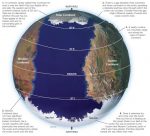
What Oceanic and Atmospheric Patterns Are Predicted for a Newly Discovered Planet?
PLANET W is a newly discovered planet that is similar to Earth. It has oceans, an atmosphere very similar to Earth's, and ice at both poles. Since no astronaut has yet ventured to the planet, we currently only know things we can observe from a distance, specifically the physical geography — the distribution of land, […]

What Influences Climates Near the Southern Isthmus of Central America?
THE SOUTHERN ISTHMUS OF CENTRAL AMERICA is geographically and climatically one of the most interesting places in the world. It is a narrow strip of land that connects Central America and South America and that separates very different waters of the Pacific and Atlantic Oceans. The climate of the region reflects intricately changing wind patterns […]

Do Other Oceans Display Oscillations?
ENSO REMAINS THE GREATEST CAUSE of climatic variability on a global scale, but oscillations have been identified in other ocean basins and shown to have regional impacts. Whether these phenomena are linked or “coupled” with ENSO is still debated, but they may be responsible for long-term variations in our climate. One such oscillation occurs in […]

How Does an El Niño Start and Stop?
THE ENSO PHASES, EL NINO AND LA NINA, have profound impacts throughout the Pacific basin and neighboring continents. What begins as a local adjustment in sea level and depth of the thermocline in the western Pacific can spread across the equatorial Pacific, triggering an El Nino. Once established, an El Nino directly impacts weather in […]

Do Impacts of ENSO Reach Beyond the Tropics?
WHILE THE IMMEDIATE IMPACTS OF ENSO are restricted to regions near the equatorial Pacific, shifts between different phases of ENSO cause climate variability well beyond the equator and the Pacific. When atmospheric conditions in one region affect a distant region, these distant associations are called teleconnections, which in this case are caused by interactions with […]

What Are the Phases of ENSO?
THE ATMOSPHERE OCEAN SYSTEM in the equatorial Pacific is constantly changing. Although each year has its own unique characteristics, certain atmosphere-ocean patterns repeat, displaying a limited number of modes. We can use surface-water temperatures in the eastern equatorial Pacific to designate conditions as one of three phases of the El Nino-Southern Oscillation (ENSO) system — […]
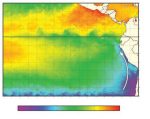
What Are El Niño and the Southern Oscillation?
THE MOST WELL KNOWN AND PUBLICIZED cause of climate variability, floods, droughts, hurricanes, heatwaves, and landslides is a change in the strength of winds and ocean currents west of South America in what has become known as El Nino. El Nino is one expression of the ocean-atmosphere system operating over and within the equatorial Pacific […]

What Connects Equatorial Atmospheric and Oceanic Circulation?
EQUATORIAL AND TROPICAL REGIONS are areas of greatest excess energy. The interaction of ocean and atmosphere systems there have great implications for climate and its variability in other parts of the world. In the same way that the Hadley cells establish connections between latitudes, there are large-scale, east-west connections within the equatorial atmosphere-ocean system. These […]

How Are the Atmosphere, Oceans, and Cryosphere Coupled?
THE SURFACE OF THE OCEANS marks the boundary between Earth’s major systems — oceans and atmosphere. Both systems move mass and energy laterally and vertically, primarily in response to variations in density and to the equator-to-pole energy gradient. Deep-flowing abyssal waters are generally cooler and denser than surface waters, but they rise in some places […]
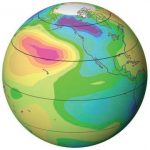
Atmosphere-Ocean-Cryosphere Interactions
OVER 70% OF THE PLANET'S surface is covered by oceans, which exchange energy and moisture with the overlying atmosphere. Oceans move in response to three main factors — winds moving over the top of them, spatial variations in the density of water, and the Coriolis effect. In addition to responding to wind directions, oceans in […]

What Do Smoke Plumes Tell Us About Atmospheric Conditions?
THE INTERACTION OF MOISTURE and varying degrees of instability in the atmosphere produce clouds, fog, and precipitation. Clues about local moisture and stability characteristics can be gained simply by looking at evidence in the everyday world. Plumes of smoke or steam coming from the top of smokestacks provide such evidence. In this investigation you will […]
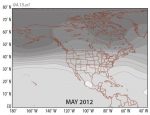
What Caused the Recent Great Plains Drought?
PARTS OF THE GREAT PLAINS, stretching from Texas to Montana, experienced severe drought in 2012, resulting in huge crop losses and other problems. These losses occurred in spite of recent technological advances, such as improved soil and water management practices and the use of drought-resistant varieties of crops. Some effects, such as crop loss, resulted […]
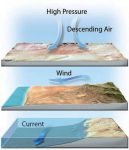
How Can Moisture Extremes Be Characterized?
THERE ARE GREAT EXTREMES in the distribution of moisture, with some regions being very dry for an extended period of time, as during a drought, whereas other regions receive huge amounts of precipitation in a short period of time. The cause of these extremes in moisture can be broad regional shifts in the climate or […]
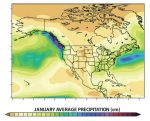
What Is the Distribution of Precipitation?
THE AMOUNT OF PRECIPITATION varies from region to region, season to season, and day to day. The daily variations are related to short-term changes in weather, but variations between regions and seasons reflect differences in the overall climatic setting, such as differences in latitude, prevailing wind directions, proximity to large water bodies, any nearby ocean […]

How Do Sleet and Freezing Rain Form?
RAIN AND SNOW ARE THE MOST COMMON forms of precipitation, but other types of precipitation are also important. The term sleet is used for a mixture of snow and rain or for precipitation as small partially frozen pellets that are too small to be called hail. Freezing rain is precipitation that reaches the ground as […]

How Does Precipitation Form?
THE PROCESS OF PRECIPITATION is vital to life on Earth, helping to redistribute water from the oceans to the atmosphere to the land. Precipitation is the ultimate source of all the fresh water on the planet, which we depend on in our daily lives. How does precipitation occur? What is going on inside clouds that […]

Where and When Is Fog Most Likely?
CERTAIN SETTINGS AND CONDITIONS are conducive to the formation of fog, so we might anticipate that some regions will have more fog than others. Also, as temperatures and humidity change with the seasons, some times of the year are likely to be foggier than other times. Considering all the places you know, which ones have […]
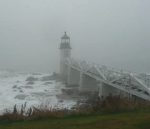
What Conditions Produce Fog?
FOG IS SIMPLY A CLOUD at ground level, so the same conditions that create a cloud also produce fog. Specifically, fog is produced by cooling of the air, by increasing the humidity of the air, or some combination, with the end result that water vapor content in the air reaches saturation. Fog forms in several […]

What Do Clouds Tell Us About Weather?
CLOUDS ARE ACCUMULATIONS of liquid water and ice suspended in the air. The types and amounts of clouds vary from place to place, from time to time, and from season to season. What are the different types of clouds, and how does each type form? Clouds provide clues not only about the amount and distribution […]
What Mechanisms Can Force Air to Rise?
AIR RISES FOR VARIOUS REASONS, some caused by differences in density between the air and its surroundings, and others a result of externally imposed factors, like a mountain. If an air parcel rises because atmospheric conditions are unstable, free convection results. If air is forced to rise due to external factors, it is called forced convection. […]

How Does the Surface Affect the Rising of Air?
EARTH'S SURFACE CONSISTS OF A VARIETY OF MATERIALS, including bare rock, soils, forests, cities, water, and ice. Each of these materials responds differently to insolation and to changes in temperature and humidity of the adjacent air. In turn, these surface materials can affect the temperature and humidity of that air. On land, these materials are […]

What Happens When Air Rises or Sinks?
THE ATMOSPHERE IS A DYNAMIC ENVIRONMENT, with upward, downward, and sideways motion. What happens to air that rises and encounters different temperatures and pressures? What happens when air sinks? The vertical motions of air cause clouds, precipitation, and many other weather phenomena. At What Rate Does an Air Parcel Cool As It Rises? To explore […]
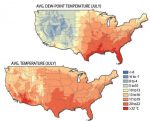
What Is the Dew Point?
ANOTHER USEFUL MEASURE OF HUMIDITY is the dew point, the temperature to which a volume of air must be cooled to become saturated with water vapor. If the air temperature is at the dew point, the air is so saturated with water vapor that vapor begins to condense as drops of liquid water, such as […]
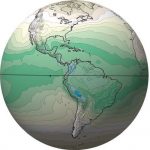
How Does Specific Humidity Vary Globally and Seasonally?
HUMIDITY OF THE AIR VARIES greatly from region to region and between different altitudes in the atmosphere. It also varies from one time to another, such as between different seasons. To compare different regions, altitudes, and seasons, we generally use specific humidity, which expresses the amount of water vapor in the air, independent of variations […]
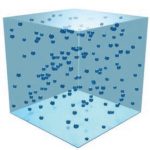
What Is Humidity?
THE AMOUNT OF WATER VAPOR in the air is referred to as humidity. Humidity is something we can sense, affecting whether the air feels humid or dry. We are most familiar with one measure of humidity — relative humidity, a term commonly used on daily weather reports. There are other measures of humidity, some of […]

How Does Water Occur in the Atmosphere?
THE PRESENCE AND ABUNDANCE OF WATER in the atmosphere are a fundamental control of weather and climate, which both have a profound influence on our lives. The molecular structure of water causes it to have special properties that we can observe every day and that are important to life on Earth. In what forms does […]

Atmospheric Moisture
MOISTURE IN THE ATMOSPHERE, in the form of water vapor, liquid water, and ice, controls most aspects of our weather and climate. Moisture moves back and forth from Earth's surface to the atmosphere and, once in the atmosphere, is transferred vertically and laterally by moving air. Atmospheric moisture is expressed as clouds, precipitation, storms, weather […]

What Occurs During Seasonal Circulation Shifts?
GLOBAL ATMOSPHERIC CIRCULATION responds directly to insolation. As the Sun's direct rays migrate seasonally, belts of winds, such as the westerlies, migrate too. In this investigation, you will examine the general circulation of the atmosphere, as expressed by data on air pressure, wind velocity, and cloud cover for two months with very different seasons — […]
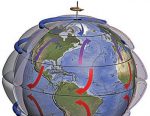
How Have Global Pressures and Winds Affected History in the North Atlantic?
INTERCONTINENTAL TRAVEL AND TRADE have relied upon moving currents in the air and oceans. Before the 20th century, when transoceanic travel and shipping relied on wind power, global winds, such as the trade winds and westerlies, dictated which directions of travel were possible at different latitudes. The directions of global winds therefore greatly influenced the […]

What Causes Monsoons?
A COMMON MISCONCEPTION is that the word “monsoon” refers to a type of rainfall, but the word actually refers to winds that reverse directions depending on the season. One of these seasonal wind directions typically brings dry conditions and the other brings wet conditions. Monsoons impact a majority of the world's population. What Are the […]

How Does Air Circulate Aloft over the Mid-Latitudes?
SURFACE WINDS IN THE MID-LATITUDES are generally from west to east in both hemispheres, but the pattern of air movement is less well developed higher in the troposphere. The main features are two currents of fastmoving air — jet streams — that encircle the globe near the boundaries of the mid-latitudes. What factors determine the […]
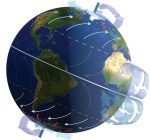
How Does Surface Air Circulate in Mid-Latitudes?
THE MID-LATITUDES are regions, in the Northern Hemisphere and Southern Hemisphere, that lie between the tropics (23.5°) and polar circles (66.5°). Air circulation in the mid-latitudes is driven by pressures set up by circulation in the adjacent tropics and polar regions, and by the Coriolis effect. Surface winds within most of the mid-atitudes blow from […]
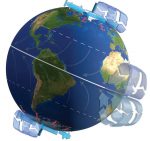
How Does Air Circulate in High Latitudes?
POLAR REGIONS RECEIVE LITTLE INSOLATION compared to the rest of Earth. As a result, the poles are very cold places, which experience winter darkness for months at a time. Air circulation around the poles reflects this relative lack of solar heating and also the proximity to the axis of rotation for the planet. The encroachment […]
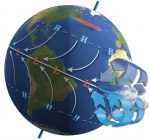
How Does Air Circulate in the Tropics?
TROPICAL CIRCULATION is driven by the intense solar heating of land and seas near the equator. The heated air rises and spreads out from the equator, setting up huge, recirculating cells of flowing air. The rising air results in a belt of tropical low pressure, and where the air descends back toward the surface is […]
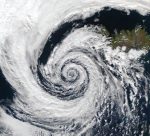
How Do the Coriolis Effect and Friction Influence Atmospheric Circulation?
THE CORIOLIS EFFECT AND FRICTION affect the patterns of air movement set in motion by pressure gradients. These phenomena influence wind direction from local scales, affecting the rotation and wind patterns of individual storms, to global scales, affecting wind patterns of the entire planet. How do pressure gradients, the Coriolis effect, and friction explain wind […]

How Does the Coriolis Effect Influence Wind Direction at Different Heights?
PRESSURE GRADIENTS INITIATE MOTION in the atmosphere, but the actual direction in which the air moves is greatly influenced by the Coriolis effect. Close to the surface, where friction with the planetary surface is greatest and wind velocities are lowest, the pressure gradient dominates. Higher in the atmosphere, winds have higher velocities and the Coriolis […]

What Is the Coriolis Effect?
THE PRESSURE-GRADIENT FORCE drives airflow in the atmosphere, but winds do not blow in exactly the direction we would predict if we only consider pressure gradients. All objects — whether air masses, ocean waters, or airplanes — moving across the surface of the Earth display an apparent deflection from the objects' intended path. The cause […]
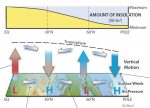
How Do Variations in Insolation Cause Global Patterns of Air Pressure and Circulation?
SEASONAL AND LATITUDINAL VARIATIONS IN INSOLATION cause regional differences in air pressure, which in turn set up regional and global systems of air circulation. These circulation patterns account for many of the characteristics of a region's climate (hot, cold, wet, dry), prevailing wind directions, and typical weather during different times of the year. Here, we […]

What Are Some Significant Regional Winds?
DIFFERENCES IN AIR PRESSURE cause a variety of regional to local wind conditions, such as those associated with storms, which are discussed in the chapter on weather. Some local winds are not so much related to weather systems as they are to differences in pressure that tend to occur at certain times of the year […]

How Do Variations in Temperature and Pressure Cause Local Atmospheric Circulation?
PRESSURE GRADIENTS INDUCE FLOW at all scales, including local and regional ones, arising from unequal heating by insolation and latent heat, by differing thermal responses of land versus sea, and even from the construction of large metropolitan areas. Such circulations contribute to the climate of a place, particularly in the absence of, or interaction with, […]

What Causes Pressure Variations and Winds?
THE MOVEMENT OF AIR IN THE ATMOSPHERE produces wind, or movement of air relative to Earth's surface. Circulation in the atmosphere is caused by pressure differences generated primarily by uneven insolation. Air flows from areas of higher pressure, where air sinks, to areas of lower pressure, where air rises. How Do We Measure the Strength […]
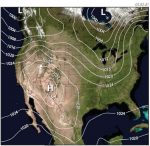
What Is Air Pressure?
PRESSURE OF GASES WITHIN THE ATMOSPHERE is highly variable, both vertically and laterally. These variations in pressure define the structure of the atmosphere and also determine the nature and direction of atmospheric motions. If one place in the atmosphere has higher pressure than another place, this imbalance of pressure (and therefore also atmospheric mass) must […]

How Do Gases Respond to Changes in Temperature and Pressure?
THE ATMOSPHERE CONSISTS LARGELY OF GASES, with lesser amounts of liquids, such as drops of water, and solids, such as dust and ice. By nature, gases expand easily or contract in volume in response to changes in temperature and pressure. Variations in temperature and resulting changes in pressure are the main drivers of motion in […]
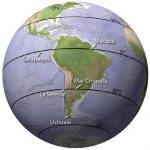
How Do We Evaluate Sites for Solar-Energy Generation?
SOLAR ENERGY IS A RENEWABLE SOURCE of light, heat, and electricity. Solar energy is typically collected with a solar panel, which can generate electricity or can heat air, water, or some other fluid. You have an opportunity to evaluate the solar-energy potential of five sites in South America, using concepts you have learned about insolation […]

How Are Variations in Insolation Expressed Between the North and South Poles?
VARIATIONS IN INSOLATION, both as a function of latitude and from season to season, help explain many aspects of our world — average temperatures, hours of daylight, type of climate and weather, the type of landscape, and the overall livability of a place. For a transect down the west coasts of the Americas, from the […]
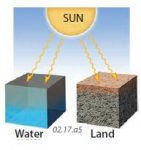
Why Do Temperatures Vary Between Oceans and Continents?
WATER EXHIBITS VERY DIFFERENT thermal properties from those displayed by the rocks and soil of land. These differences in thermal properties cause oceans and land to warm and cool at different rates, leading to significant temperature variations between oceans and land. Such differences help explain major patterns of global temperature and climate. How Do Water […]
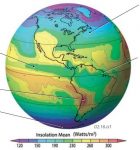
How Do Insolation and Outgoing Radiation Vary Spatially?
FLOWS OF ENERGY into and out of Earth's system vary spatially, as a function of latitude, land or sea, cloud cover, and many other factors. The pattern of insolation also changes over several timescales, from daily rotation of the planet to the longer changes in season, causing spatial and temporal imbalances — zones of surplus […]

How Does Earth Maintain an Energy Balance?
SIXTY-NINE PERCENT OF INSOLATION received at the outside of the Earth's atmosphere is available for sensible, ground, and latent heating. Ultimately all of this energy must be returned to space as longwave radiation in order to attain a balance between incoming and outgoing radiation. A greater loss to space would cool the global system, and […]
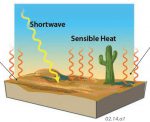
What Happens to Insolation That Reaches the Surface?
APPROXIMATELY HALF OF INSOLATION is transmitted to Earth's surface, and this energy is variably reflected, absorbed, and re-emitted. Earth absorbs energy of short wavelengths, including insolation, but re-emits it at longer wavelengths. Certain greenhouse gases in the Earth's atmosphere interact with this outgoing long-wavelength radiation, complicating the return of this energy to space and helping […]

How Much Insolation Reaches the Surface?
NOT ALL INSOLATION reaches Earth's surface. Much of it is intercepted (absorbed, scattered, or reflected) by the atmosphere. Measurements and models allow us to account for the destination of insolation globally. Approximately 69% of the energy arriving at the top of the atmosphere remains in the Earth's system, of which 20% is stored (absorbed) in […]
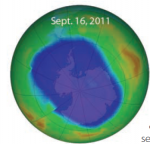
What Is Ozone and Why Is It So Important?
OZONE IS AN ESSENTIAL GAS in the atmosphere, shielding life on the surface from deadly doses of ultraviolet radiation from the Sun. In the past several decades, there has been major concern about the loss of ozone in our atmosphere, particularly a seasonal decrease in ozone above Antarctica. How can a gas that generally constitutes […]

How Does Insolation Interact with the Atmosphere?
INSOLATION REACHES THE EARTH but has to pass through the atmosphere before it reaches us. The atmosphere does not transmit all of the Sun's energy; some wavelengths of energy are partially or completely blocked by atmospheric components, such as gas molecules. The interactions between insolation and the atmosphere explain many aspects of our world, like […]

What Controls When and Where the Sun Rises and Sets?
THE SUN RISES EACH MORNING and sets each evening, but at slightly different times from day to day. Also, the Sun does not rise or set in exactly the same direction every day, although the changes from day to day are so gradual as to be unnoticeable. Over the course of several months, however, we […]

Why Do We Have Seasons?
DURING THE YEAR MOST LOCATIONS progress through different seasons, from warmer summers to cooler winters and back again. The progression from season to season accompanies changes in the position of the Sun, such as from higher in the sky during the summer to lower in the sky during the winter. Except at the equator, the […]

Why Does Insolation Vary from Place to Place?
DESPITE A FAIRLY CONSISTENT supply of energy from the Sun, considerable differences in the quantity of insolation are experienced between the poles and equator, and also over several timescales — most noticeably, changes between seasons and between night and day. On Earth, variations in insolation are mostly related to latitude. What Controls the Insolation Reaching […]
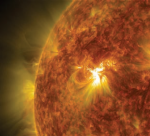
What Causes Changes in Insolation?
THE ENERGY TRANSMITTED from the Sun to Earth, called incoming solar radiation, or insolation, has varied only slightly during the short time for which we have accurate measurements from satellites. How much energy do we receive from the Sun, and why does it vary at all? How Much Energy Is Transferred from the Sun to […]

What Controls Wavelengths of Radiation?
ELECTROMAGNETIC RADIATION takes many different forms, each of which have very different properties, determined by their wavelengths. Variations in wavelength explain the existence of different colors and warming of the Earth due to climate change. How are differences in the wavelength of electromagnetic energy (EMR) expressed in our world and in the Solar System? What Range […]

What Is Electromagnetic Radiation?
ELECTROMAGNETIC RADIATION is one of the fundamental forces of nature. It dominates our daily interactions with the world, determining the color of objects, the character of the air we breathe, and the physical characteristics of the water we drink. Electromagnetic radiation is essential to the operation of weather and our climate system and to all […]
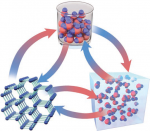
What Is Latent Heat?
WATER OCCURS IN ALL THREE PHYSICAL STATES —solid, liquid, and gas — at temperatures commonly found on Earth. Although the chemical structure of water remains unchanged from state to state, the three states, also called phases, are differentiated by the physical spacing of the water molecules. Considerable quantities of energy, contained as latent heat, are […]
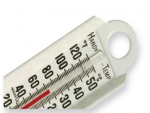
What Are Heat and Temperature?
THE TERMS HEAT AND TEMPERATURE are used every day, but what do they actually mean? Temperature is a measure of the object's internal kinetic energy — the energy contained within molecules that are moving, and heat is thermal energy transferred from one object to another. Moving molecules drive many processes in the Earthocean-atmosphere system, such […]

What Is Energy and How Is It Transmitted?
THE TRANSMISSION OF ENERGY, and the interactions between energy and matter, define the character of our planet and control weather, climate, and the distribution of life, including humans. Here, we examine the fundamentals of energy, including what it is, where it comes from, and how it is moved from one place to another. What Is […]
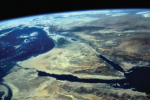
What Is the Atmosphere?
A RELATIVELY THIN LAYER OF GAS — the atmosphere — surrounds Earth's surface. The atmosphere shields us from harmful high-energy rays from space, is the source of our weather and climate, and contains the oxygen, water vapor, and other gases on which all life depends. What is the character and composition of the atmosphere, and […]

Energy and Matter in the Atmosphere
TOPICS IN THIS CHAPTER What Is the Atmosphere? What Is Energy and How Is It Transmitted? What Are Heat and Temperature? What Is Latent Heat? What Is Electromagnetic Radiation? What Controls Wavelengths of Radiation? What Causes Changes in Insolation? Why Does Insolation Vary from Place to Place? Why Do We Have Seasons? What Controls When […]
Layers of the atmosphere
The sky is the very definition of vastness. When we take a boat to sea or find ourselves on a treeless plain, were reminded just how all-encompassing the sky can feel. Its easy to believe the atmosphere must go on forever, stretching outward and upward. Try this perspective, though: Earth as seen from the US […]
Welcome to our atmosphere
An old pop song tells us that “love is like oxygen”. A politician concerned about the environment is accused of being “out in the ozone”. Computer programs that exist only in a promoters press releases are dubbed “vapourware”. Oxygen, ozone and water vapour are three of the most familiar ingredients in the life-sustaining soup we […]

Atmospheric layers
Like the solid Earth, the atmosphere is divided into distinct layers. Take a deep breath: you have just inhaled part of the troposphere, the lowest layer of the atmosphere. A little like the Earths crust below' your feet, the amount of troposphere above you varies with your location. Near the Equator it is about 16km […]

Atmospheric special effects
Even with no clouds in the sky, there are plenty of amazing atmospheric phenomena to look at. Many, it turns out, are to do with ice. The most basic is a ring of light seen around the Sun or Moon when conditions are cold enough for there to be ice crystals at altitude. It is […]
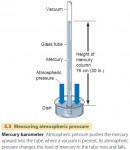
Atmospheric Pressure
We live at the bottom of a vast ocean of air—the Earth's atmosphere. Like the water in the ocean, the air in the atmosphere is constantly pressing on the Earth's surface beneath it and on everything that it surrounds. The atmosphere exerts pressure because gravity pulls the gas molecules of the air toward the Earth. Gravity is an attraction among all […]

Temperature Structure of the Atmosphere
In general, the air is cooler at higher altitudes. Remember from Chapter 2 that most incoming solar radiation passes through the atmosphere and is absorbed by the Earth's surface. The atmosphere is then warmed at the surface by latent and sensible heat flows. So it makes sense that, in general, air farther from the Earth's surface will be cooler. We call […]
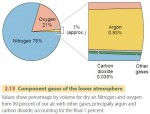
Composition of the Atmosphere
The Earth is surrounded by air—a mixture of various gases that reaches up to a height of many kilometers. This envelope of air makes up our atmosphere (Figure 2.13). It is held in place by the Earth's gravity. Almost all the atmosphere (97 percent) lies within 30 km (19 mi) of the Earth's surface. The upper limit of the atmosphere is […]